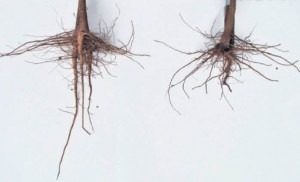Soil-Matters Spring 2010

Looking Forward To A Golden Harvest In Kansas
Stuart (Stu) Beckman a 3rd generation farmer of Menlo, KS and top Golden Harvest seed dealer was recently interviewed by Pro-Soil.
How long have you been farming?
It started back when my father let me farm a quarter section of corn as a freshman in high school. At graduation he let me buy a 1/2 section irrigated! That was a big deal back in those days.
Initially you were skeptical about using Pro-Soil. What changed your mind?
Eventually it was results, but it wasn’t until year three that I was totally convinced. Until then I trusted Ray Trent. I felt like he knew what he was talking about. He kept telling me to give it 3 years before passing judgment. It will pay off he would say. I reluctantly gave him the benefit of the doubt since he came out to my farm every year to check our fields and always had a great joke to tell. (laughing)
What kind of results have you observed?
The first year we tested everything, irrigated, dryland, corn, beans and wheat. It didn’t show us a lot in yield, but I remember it alwayspaid for itself. Also, we noticed the Pro-Soil treated wheat looked a lot better than the control. Bigger roots, just a healthier looking plant overall. I still think it looked 5 bushel better than the untreated, although it tested about the same.
The 2nd year we focused on corn and turned in a 7 bushel/acre increase, which got myself and my sons attention. When Ray came out we looked at roots and the treated plants were definitely bigger and deeper in the soil.

This last year (2009) we treated all acres of irrigated corn. The numbers were exciting. We yielded 260.9 bushel/acre on the untreated acres and 275.7 bushel/acre on the Pro-Soil treated acres, an overall yield increase of 14.8 bushel/acre! The numbers don’t lie. This makes using Pro-Soil a no brainer to me. Now I have another tool to help my operation make more NET profit per acre!
What was your highest yielding plot?
277 bushel/acre and a Pro-Soil treated plot.
Research Briefs
Pro-Soil Cotton Grower Wins Award
Johnny Lindley of Lakeview, TX began using Pro-Soil products on his West Texas cotton crop in 2008. All Pro-Soil treated fields yielded over 2,000 lbs/acre and entry into the FiberMax One Ton Club.
The club recognizes growers who produce 2,000 lbs or more of lint cotton per acre on at least 20 acres using FiberMax cotton. He also won the Individual award for Most Acres over one ton at 269.
On a recent visit to the Lindley Farm, Johnny reported to Pro-Soil’s National Field Advisor Ray Trent & Dealer Tim Wyatt “on the Pro-Soil treated fields there was a definite increase in overall plant root mass, a softer more permeable soil allowing water to soak in a little better.”
Cotton:
Three Year Study Determines Pro-Soil’s
Foundation Formula is a Profitable Alternative.
Replicated Yield Results:
Using Pro-Soil’s Formula on Cotton vs. Conventional Treatment

Out of sight out of mind, soil dwelling organisms can be greatly influenced by agricultural practices. Tilling the soil can kill large soil dwelling organisms and reduce the number of earthworms. Pesticides can exterminate microbes and microfauna. Conventional short-rotation, single-crop farming can reduce the diversity, abundance, and activity of beneficial soil fauna, and indirectly encourage proliferation of soil bourne viruses, pathogens, and crop eating insects.
Source: dirt: The Erosion of Civilization
REPORTS FROM THE FIELD:
Real Farm Results: 2009 Cotton
Bio Brings Earthworms Back

I first Became aware of bio’s (biological fertilizers) in 2001 as I recognized there were no more earthworms in my fields. Immediately, I suspected that something was missing (in my soils.)
I have been using the Pro-Soil products since 2001 and have noticed more worms in my ground and the soil has become mellower with increased permeability resulting in crop yield increases. The products definitely work!!!
Bobby Felton
Circle Three Farms
Childress, TX
Advice From A Cotton Grower
I started using Pro-Soil Products in 2005 on a Texas cotton crop. This will be my 5th consecutive cropping season using the Pro-Soil products. Some of the more noticeable results from the product are the massive root growth, softer soil, more early vigor and the increase in the number of earthworms.
My advice to help fellow farmers is to keep a close eye on your bottom line evaluating your input costs throughout the year. I believe in the (Pro-Soil) product or I wouldn’t be using it. Plain and simple.
The first year on the Pro-Soil product I had a test plot & could tell a big difference. After that I decided to put it on every acre.
It was a good decision.
Jason Poole
Jason Poole Farms
Quanah, TX
Does Fertilizer Harm Soil Microbes?
Microbes in the soil are important to the nourishment of plants. Many of them facilitate the chemical conversions and physical transport needed to make nutrients available. Some people claim that soil microbes should supply all the nutrients needed by plants. Some also claim that applying soluble forms of plant nutrients harms the biology in the soil and reduces its capacity to make the native soil nutrients available. Let’s look at the evidence.
The microbes that supply nitrogen (N) are from two categories—symbiotic and free-living. The symbiotic types are mainly rhizobial bacteria that infect the roots of legumes, such as alfalfa and soybeans. These bacteria supply the bulk of the N needs of legumes. However, even genetic engineering has not yet been able to coax the non-legume crops—corn, wheat, canola, potatoes, and many others—to fix N. Most crops depend on N applications in the form of fertilizer, manure, or organic materials.
The free-living bacteria in the soil supply some N as well, but the amounts are limited and are not influenced by fertilizer. A paper published in the journal Nature in 1998 compared nutrient dynamics in three Pennsylvania crop rotations: one fertilized, one manured, and one legume-based. The study found that the free-living bacteria supplied less than 5 lb/A/year, an amount that did not differ between the three rotations. No evidence of harm.
Microbes that help supply phosphorus (P) form an association with plant roots. The association is called “mycorrhizae”, a term that means “fungus-root.” Fungi explore the soil better than roots, because their hyphae are narrower. They can bring P to the root from as far as 4 in. away.
Mycorrhizal fungi depend on the plant for energy in the form of sugar. It is well known that they are more active when P is deficient. But sugar used to feed the mycorrhizae is sugar taken away from grain yield. For example, in a recent field experiment in Quebec, corn depending on mycorrhizae yielded 14% less than when fertilized with P. The fertilizer—even though it was applied at twice the recommended rate—reduced the density of fungal hyphae by 24%, but certainly did not eliminate it. When soil test levels are low, P additions can actually increase mycorrhizal development.
Scientists have recently discovered that mycorrhizae produce a unique substance called glomalin. It may form as much as 30% of the organic matter in soil, and it seems to help maintain soil structure. Dr. Sara Wright, a noted expert on glomalin, recently stated that the best field-scale management for the production of glomalin is to “use minimal disturbance, add no more phosphorus than is required for crop production, and use cover crops.”
Soil microbes depend on plants for their nourishment. Fertilizers that nourish plants also nourish the biology of the soil.
© 2004. Potash & Phosphate Institute of Canada (PPIC) Kathy Hefner, Envirobriefs No. 16 – PPI-PPICC
Ask an Expert
Q: If I am applying Pro-Soil products do I still need to use a nitrogen stabilizer or additional products that help make phosphorus more available to the plant?
A: As with any recommendation, many factors come into play involving the release of macro and micronutrients. Soil testing for the availability of nutrients as well as calcium to magnesium ratios, sulfur availability and heavy metal toxicity all play an important part of nutrient release to the plant. Pro-Soil products contain an enzyme concentrate that works to feed and stimulate microbial activity. By increasing the beneficial microbe population in your soil you are working toward increasing the efficiency of all applied nutrients. However, there may be specific individual circumstances that still warrant adding an N Stabilizer or a Phosphorus release type product. They would be as follows:
- During cold and wet conditions at planting time nutrients tend to be more immobile.
- In the event of very low or phosphorus depleted soils where crops have been known to show phosphorus deficiency.
Remember that your Pro-Soil products are working for you to improve soil conditions by increasing root mass, improving pore space and providing a scientifically engineered nutrition source for your microbe populations. These improvements can help by allowing the plant to come in contact with more nutrients (roots) allowing roots to grow deeper with more mass (pore space) and by converting more of the root mass to organic matter and plant available nutrients (microbial activity).
Have a question for Ray?
Email: ask@soil-matters.com or Call 1-800-714-4903
Ray Trent has been helping farmers solve problems for over 15 years. As National Field Advisor for Pro-Soil AgSolutions, Inc., Ray walks between 200,000 to 300,000 crop acres a year.
